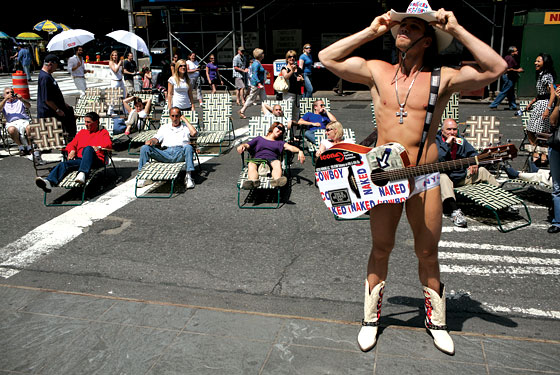
For the moment, at least, Times Square is once again a spectacularly crazy place—crazy enough on a recent afternoon to make a seasoned police officer shake his head with a bemused grin and mutter, “Just when you thought you’d seen everything …” People were sitting on lawn chairs in the middle of Broadway. If, as the anthropologist Mary Douglas asserted, dirt is matter out of place, then this crowd of pedestrians occupying vehicular lanes represented an invigorating sort of filth, a thrilling overthrow of order.
So far, this revolution is thrown together with nothing but orange cones and cheap patio furniture. The fearless Transportation commissioner, Janette Sadik-Khan, decided that it’s better to take back turf for foot traffic first and worry about piazza-tizing it later. The absence of design results in a triumph of urbanism. Suddenly, the power relationship between people in and out of cars has changed. Now drivers pass through the area at the sufferance of pedestrians, rather than the other way around. Cars don’t honk as they nose crankily into a crosswalk; they wait politely to cross the new mall, giving drivers a moment to reflect on the wisdom of taking a different route.
The new arrangement offers the excitement of sheer incongruence. There’s the weirdness of sitting in the middle of Broadway, of course—as the cop looked on, nearly everyone sat inexplicably facing the same direction, as if waiting for a spaceship to land on 42nd Street. But the rickety seating also provides an invigorating contrast to all the shiny glass architecture draped in phenomenally pricey TV screens. Now that pedestrians have somewhere to rest and watch the whirl of commercials, the show seems to demand rows of leather armchairs, or at least a few permanent benches. And maybe some planters, too. Landscaping. A fountain, perhaps? Please: Not yet.
Sadik-Khan has said that she drew inspiration from the Strøget, the spine of streets through the center of Copenhagen, which was gradually transformed into a genteel pedestrian thoroughfare. But her Times Square takeover also recalls a different Copenhagen institution: Christiania, the decommissioned military base that hippies colonized in the early seventies, banging together a livable town out of salvage and good cheer. The authorities balked, then winked. Here, officialdom itself has bestowed a trace of that carnival atmosphere. Every day is New Year’s Eve.
The informality can’t—and shouldn’t—last. But one day, when the Broadway mall is fitted out with permanent amenities made of concrete, steel, and greenery, we’ll find ourselves nostalgic for the early days of a car-free Times Square, when people bivouacked in the middle of the street, and when the center of the world had the provisional, slightly lunatic feel of an urban encampment.
Have good intel? Send tips to intel@nymag.com.
